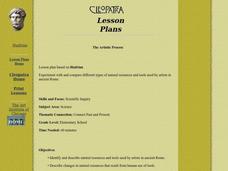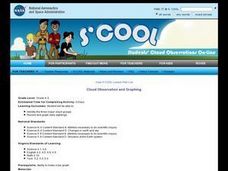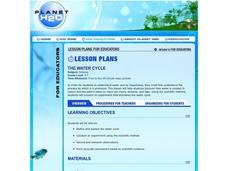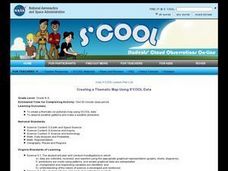Curated OER
Bird Populations
learners study bird migratory patterns and the methods that researchers use to study them. Students are introduced to the concepts of the study of bird movements.The skill of scientific questioning is used to find results.
Curated OER
What Does It Eat?
Students, working in research teams, investigate the eating habits of crickets. They collect and record data and compare their methods and results with other groups by making tables or graphs. They sumarize their findings with posters or...
Curated OER
Termite Biology
Students explore the physical characteristics, distribution and habitat of termites. The lesson focuses on the termite as a social creature contrary to most other insects.
Curated OER
How Do We Forecast Weather?
Third graders investigate how scientists collect weather data in order to forecast the weather. They work in small groups in order to research one type of weather technology such as, satellite images, radar, surface observations, or...
Curated OER
Underwater Habitats
Students make a hydrophone and attach it to their Sea Perch ROVs. They use the hydrophones in conjunction with the underwater cameras on the ROVs to explore their local aquatic environments.
Curated OER
Parachutes: Is it Surface Area or Shape?
Young scholars investigate how to make a good parachute. In this physics activity, students observe the motion of parachutes as it falls and measure the time. They collect data and calculate the average descent time for each canopy shape.
Curated OER
Measuring Water Temperature
Learners measure the temperature of three water sources. They collect data points every second for twenty five seconds for each sample using Lego Robolab temperature sensors, complete a worksheet, and analyze the data.
Curated OER
The Artistic Process
Students experiment with and compare different types of natural resources and tools used by artists in ancient Rome. They describe changes in natural resources that result from human use of tools.
Curated OER
Mathematical Proofs
Students explore the nature of mathematical proofs and mathematical inquiry. They complete the activity "Using the Pythagorean Theorem". They read selected articles and participate in class discussions.
Curated OER
Cloud Observation and Graphing
Students identify the three major cloud groups. They are introduced to the three main cloud types and spend a week making and recording observations of clouds. Students produce a graph that presents their findings and conduct research...
Curated OER
Biological Sampling Device Using a Sea Perch
Pupils construct plankton nets to be towed and collect specimens to be examined and analyzed in the classroom. They develop research skills through collection of an aquatic sample. They write lab reports after interpreting, identifying...
Curated OER
Measurement of the Depth of the Ocean
Students comprehend the physical properties of pressure and Boyle's Law by designing a depth gauge. They construct a capillary depth gauge and calculate the calibrated depth marks of the capillary tube. They determine the margin of error...
Curated OER
Attenuation of Light in Water
Students explore what happens to light intensity as depth increases using a light intensity logger. They construct a PVC model to hold water and identify what factors could influence the amount of light attenuation.
Curated OER
Rocket Physics
Students investigate the relationship between impulse, momentum, kinetic and potential energy and aerodynamic drag. In this physics lesson, students calculate data taken from launching a rocket. They compare the theoretical and actual...
Curated OER
Pendulum Lab
Students predict how changing the pendulum components affect its period. In this physics lesson, students calculate the period using different masses. They analyze lab result and complete assigned worksheet.
Curated OER
The Water Cycle
Students research the water cycle and identify main vocabulary associated with the water cycle. They build and observe a closed system model that demonstrates the water cycle in action.
Curated OER
Eat Your Sprouts Part I
Middle schoolers will conduct a lab on the oxidation of an apple. The students will learn that the oxidation process can be halted when lemon juice is applied to the flesh of an apple because the lemon juice contains vitamin C, an...
Curated OER
Yeast Cells and Their Environment
Middle schoolers create their own experiment in which they have yeast cells growing in liquid environments. They examine the relationship between humans and microorganisms. They also practice using the scientific method.
Curated OER
How Can You Study Things You Can’t See Like: Atoms?
Learners simulate how scientists studied things they can't see like atoms. In this chemistry lesson, students predict what is inside the numbered obsertainers. They design a way to investigate what's inside without opening it.
Curated OER
Mud Fossils
Students create their own fossils in an activity using plaster of paris and a variety of objects which can be fossils, e.g. chicken bones, twigs, shells, etc. After making their fossils, they allow them to dry and discuss time and its...
Curated OER
SIM Ecosystem
Students identify and interpret the concept of an ecosystem and the potential impact humans have on ecosystems. They also proficient in organized and methodical Internet searches. Finally, students become proficient with public...
Curated OER
Creating a Thematic Map Using S'COOL Data
Students observe weather patterns, collect data, and make a weather predictions for various locations on a map.
Curated OER
DNA-a Molecular Identity
Pupils explore about what DNA is and several different DNA typing techniques. They examine three different situations where DNA typing was used to carry out justice. Students also identify and evaluate different uses of DNA typing...
Curated OER
Household Pests
Sixth graders discover the various habitat requirements for assorted household pests from ants to wasps. They conduct various activities including researching the life cycles moths, cockroaches, and mosquitoes

























